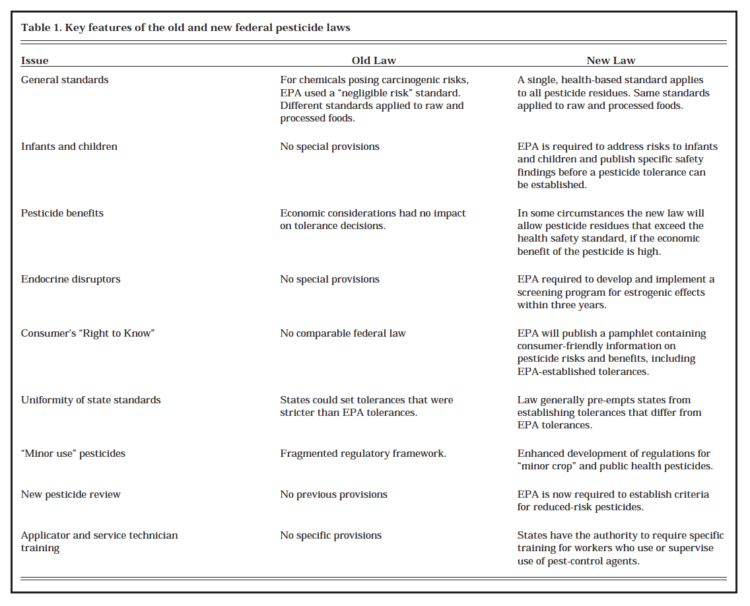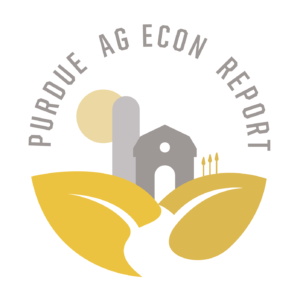Federal Pesticide Regulation: Recognizing Economics of Use and Consumer Safety
August 18, 1997
PAER-1997-04
Gerald E. Shively, Assistant Professor
Pesticides are an important part of our food system from the economic benefits of producer use to the health implications of the food we enjoy. Recent changes are helping to fine tune federal legislation that recognizes the important economic benefits of use and also enhances consumer safety.
Changes in legislation!
The Food Quality Protection Act (FQPA) of 1996 is the most recent Federal legislation directed at food safety. Voted unanimously into law last August, this new legislation (P.L. 104-170) replaces the 1958 Delaney Clause amendment to the Federal Food, Drug, and Cosmetic Act (FFDCA), and also amends the Federal Insecticide, Fungicide, and Rodenticide Act (FIFRA). The old law treated pesticides on processed foods as additives, but exempted certain pesticide residues found in raw foods. The FQPA removes this distinction and establishes a single, health-based standard for pesticide residues in both raw and processed food. Major differences between the old law and the new law are summarized in Table 1.
The new law includes several features that are likely to have far-reaching effects on food producers and consumers over the coming decades. These effects will arise primarily from a shift in regulatory emphasis. Previously, federal law concerned with regulating pesticide residues aimed to distinguish between carcinogens and noncarcinogens in the food supply. The new law will abandon this approach in favor of a broader perspective that identifies “threshold” and “nonthreshold” pesticides, regardless of their cancer-causing potential.
The Environmental Protection Agency (EPA) will be given responsibility for interpreting safe threshold levels for all pesticides, not just those that pose a cancer threat. Exact interpretations of what constitutes a safe threshold will likely be the subject of scientific and legislative debate in the years to come. The new law also requires the development and implementation of a screening program for endocrine disruptors. These estrogen-like sub-stances are suspected of having harmful effects on human reproduction and development.
What can producers expect?
Although the ultimate impact of the new legislation is difficult to predict, it seems clear that most pesticides that were available under the old law are likely to remain available under the new law. The FQPA pro-vides for a review of all existing pesticide tolerances within the next 10 years, with highest priority given to pesticides that may pose the greatest health risks. Faster reviews of new agricultural and antimicrobial pesticides will mean that pesticide manufacturers are likely to seek—and gain—approval to market previously banned pesticides that were found to be carcinogenic but at a small “threshold” level. Over time, this change is likely to increase the number of approved fungicides, herbicides, and insecticides.
In some cases, the new rules may lead to prohibitions on previously approved products, especially if observed residue levels are shown to exceed “threshold” levels of safe exposure. Overall, most of the chemicals on which farmers previously relied will remain available, and newer and safer products are likely to replace some currently approved pesticides. In addition, the new law seeks to enhance incentives for adoption of integrated pest management (IPM) strategies by developing guide-lines for the review and registration of pesticides that reduce risk to human health and non-target organisms.
How will consumers be affected?
An important provision of the FQPA adds additional safety factors to ensure that infants and children—who are particularly sensitive to pesticides and other food additives—will be adequately protected from unsafe levels of pesticides. Thus the FQPA is likely to lead to increased testing for pesticide residues—especially on fresh fruits and vegetables. This increased screening is likely to enhance food safety, but may also add to the average house-hold’s grocery bill. In addition, the new law requires the EPA to publish information on pesticide risks and benefits for distribution through retail grocers.

Table 1. Key features of the old and new federal pesticide laws
